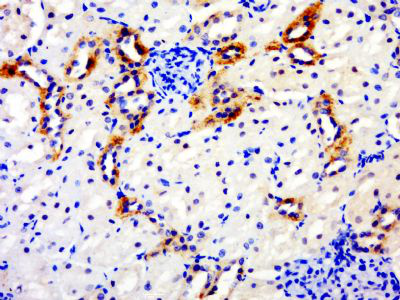产品货号 : mlR16274
英文名称 : GPD1L
中文名称 : 甘油-3-磷酸脱氢酶1样抗体
别 名 : 2210409H23Rik; D9Ertd660e; Glycerol 3 phosphate dehydrogenase 1 like; Glycerol 3 phosphate dehydrogenase 1 like protein; Glycerol-3-phosphate dehydrogenase 1-like protein; GPD 1L; GPD1-L; gpd1l; GPD1L_HUMAN; KIAA0089; RGD1560123.
研究领域 : 肿瘤 心血管 细胞生物 信号转导 新陈代谢
抗体来源 : Rabbit
克隆类型 : Polyclonal
交叉反应 : Human, Mouse, Rat, Chicken, Dog, Cow, Sheep,
产品应用 : ELISA=1:500-1000 IHC-P=1:400-800 IHC-F=1:400-800 ICC=1:100-500 IF=1:100-500 (石蜡切片需做抗原修复)
not yet tested in other applications.
optimal dilutions/concentrations should be determined by the end user.
分 子 量 : 38kDa
细胞定位 : 细胞浆
性 状 : Lyophilized or Liquid
浓 度 : 1mg/ml
免 疫 原 : KLH conjugated synthetic peptide derived from human GPD1L:201-300/351
亚 型 : IgG
纯化方法 : affinity purified by Protein A
储 存 液 : 0.01M TBS(pH7.4) with 1% BSA, 0.03% Proclin300 and 50% Glycerol.
保存条件 : Store at -20 °C for one year. Avoid repeated freeze/thaw cycles. The lyophilized antibody is stable at room temperature for at least one month and for greater than a year when kept at -20°C. When reconstituted in sterile pH 7.4 0.01M PBS or diluent of antibody the antibody is stable for at least two weeks at 2-4 °C.
PubMed : PubMed
产品介绍 : The protein encoded by this gene catalyzes the conversion of sn-glycerol 3-phosphate to glycerone phosphate. The encoded protein is found in the cytoplasm, associated with the plasma membrane, where it binds the sodium channel, voltage-gated, type V, alpha subunit (SCN5A). Defects in this gene are a cause of Brugada syndrome type 2 (BRS2) as well as sudden infant death syndrome (SIDS). [provided by RefSeq, Jul 2010]
Function:
Play a role in regulating cardiac sodium current; decreased enzymatic activity with resulting increased levels of glycerol 3-phosphate activating the DPD1L-dependent SCN5A phosphorylation pathway, may ultimately lead to decreased sodium current; cardiac sodium current may also be reduced due to alterations of NAD(H) balance induced by DPD1L.
Subcellular Location:
Cytoplasm. Localized to the region of the plasma membrane.
Tissue Specificity:
Most highly expressed in heart tissue, with lower levels in the skeletal muscle, kidney, lung and other organs.
DISEASE:
Defects in GPD1L are the cause of Brugada syndrome type 2 (BRS2) [MIM:611777]. BRS2 is an autosomal dominant tachyarrhythmia characterized by right bundle branch block and ST segment elevation on an electrocardiogram (ECG). It can cause the ventricles to beat so fast that the blood is prevented from circulating efficiently in the body. When this situation occurs (called ventricular fibrillation), the individual will faint and may die in a few minutes if the heart is not reset.
Defects in GPD1L are a cause of sudden infant death syndrome (SIDS) [MIM:272120]. SIDS is the sudden death of an infant younger than 1 year that remains unexplained after a thorough case investigation, including performance of a complete autopsy, examination of the death scene, and review of clinical history. Pathophysiologic mechanisms for SIDS may include respiratory dysfunction, cardiac dysrhythmias, cardiorespiratory instability, and inborn errors of metabolism, but definitive pathogenic mechanisms precipitating an infant sudden death remain elusive.
Similarity:
Belongs to the NAD-dependent glycerol-3-phosphate dehydrogenase family.
SWISS:
Q8N335
Gene ID:
23171
Important Note:
This product as supplied is intended for research use only, not for use in human, therapeutic or diagnostic applications.
产品图片












